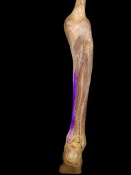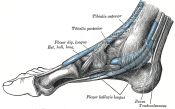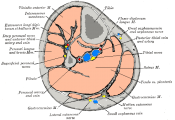Flexor Digitorum Longus
Original Editor - George Prudden
Top Contributors - George Prudden, Kim Jackson, 127.0.0.1, Evan Thomas, WikiSysop, Abbey Wright, Pinar Kisacik and Patti Cavaleri;
Description[edit | edit source]
Origin[edit | edit source]
Posterior surface of the body of the tibia.
Insertion[edit | edit source]
Plantar surface, base of the distal phalanges of the four lesser digits.
Nerve[edit | edit source]
Tibial nerve
Artery[edit | edit source]
Posterior tibial artery[1]
Function[edit | edit source]
Flexes phalanges of second to fifth digits as the foot is raised from the ground. Additionally stabilises the metatarsal heads and keeps distal pads of toes in contact with ground in toe-off and when on tip-toe
Clinical relevance[edit | edit source]
Assessment[edit | edit source]
Palpation[edit | edit source]
Power[edit | edit source]
Length[edit | edit source]
Treatment[edit | edit source]
Strengthening[edit | edit source]
Stretching[edit | edit source]
Manual techniques[edit | edit source]
Resources[edit | edit source]

|

|

|
File:FDL4.JPG | 
|
See also[edit | edit source]
- Flexor hallucis longus
- The Os Trigonum Syndrome
- Tarsal Tunnel syndrome
- Posterior Tibial Tendon Dysfunction
- Ankle & Foot
- Compartment Syndrome of the Foot
- Ankle Impingement
- Hallux Valgus
- Ankle Joint
- Congenital talipes equinovarus (CTEV)
Recent Related Research (from Pubmed)[edit | edit source]
References[edit | edit source]
- ↑ Saladin K. Anatomy & physiology: The Unity of Form and Function. 5th ed. New York: McGraw-Hill; 2010.







